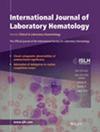Paediatric Reference Intervals and Curves for Haemoglobin Estimated Using Direct Methods: A Systematic Review and Meta-Analysis
Abstract
Introduction
Haemoglobin is a commonly ordered laboratory test, used to assess both individual and population-level health. To interpret test results, laboratories provide reference intervals (RIs) with lower (2.5th%) and upper (97.5th%) limits according to age and sex. Reference curves (RCs) treat age as a continuous variable. The objectives were to synthesise evidence on Paediatric haemoglobin RIs/RCs and investigate possible sources of heterogeneity. We placed our findings in the context of the age- and sex-based haemoglobin thresholds to define anaemia, recommended for international use by WHO.
Methods
We conducted a systematic review of studies publishing Paediatric haemoglobin RIs/RCs (PROSPERO: CRD42023399802). EMBASE, MEDLINE, SCOPUS and The Cochrane electronic libraries were searched from inception to July 31, 2023. Studies involving unhealthy children, lacking males and females RIs/RCs, or limited to cord-blood RIs/RCs were excluded. Studies adhering to guidelines for RIs development from the Clinical Laboratory Standards Institute (CLSI) and RCs studies reporting confidence intervals (CIs) were included in the meta-analysis. Lower and upper males and females RI limits were pooled for age groups with heterogeneity I2 < 75%. All studies meeting eligibility criteria were included in the narrative synthesis. Sources of heterogeneity were analyzed using heatmaps, forest plots and Shiny app.
Results
Of 9123 studies screened, 177 were retained for full-text review. We identified 48 eligible studies (63 529 male and 59 969 female participants) from 25 countries (4 continents) published 1938–2023. There was inconsistency in age partitioning and length of age intervals. Meta-analysis was conducted on 13 studies reporting RIs and 2 studies reporting RCs. Pooled estimates for the 0–3 months age group could not be generated for males or females due to paucity of data. For children aged 3 months or older, both lower and upper RI limits generally increased with age, from approximately 100 to 130 g/L and from approximately 130 to 150 g/L, respectively. For visualisation of our narrative synthesis of all 48 studies, we created a novel web-based computational tool using Shiny-app. Sources of heterogeneity included child age, sex, analyser type and country. For many studies, the lower RIs were substantially different from WHO anaemia thresholds. Study limitations include a small sample size for younger age groups, potentially impacting heterogeneity estimates, reliance on CLSI guidelines due to the lack of a suitable quality assessment tool for RIs/RCs and restriction to English-language studies.
Conclusion
Evidence synthesis of locally developed Paediatric haemoglobin RIs/RCs revealed substantial heterogeneity, suggesting the need for more rigorously developed estimates that may be used globally along with WHO thresholds to define anaemia. Future research is needed on RIs for the youngest children. Percentile curves should be explored to provide continuous haemoglobin charts.


 求助内容:
求助内容: 应助结果提醒方式:
应助结果提醒方式:


